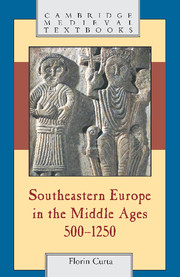Book contents
- Frontmatter
- Contents
- List of maps
- Acknowledgments
- Note on transliteration, names, dates, and words
- Chronology
- List of abbreviations
- Introduction
- 1 The end of Late Antiquity or the beginning of the Middle Ages (c. 500–c. 600)?
- 2 Southeast European “Dark Ages” (c. 600–c. 800)
- 3 The rise of new powers (800–900)
- 4 Iron century or golden age (900–1000)?
- 5 The first Byzantine century (1000–1100)
- 6 The second Byzantine century (1100–1200)
- 7 Between the Crusade and the Mongol invasion (1200–1250)
- 8 Conclusions and lingering questions
- Select Bibliography
- Index
- Cambridge Medieval Textbooks
2 - Southeast European “Dark Ages” (c. 600–c. 800)
Published online by Cambridge University Press: 05 June 2012
- Frontmatter
- Contents
- List of maps
- Acknowledgments
- Note on transliteration, names, dates, and words
- Chronology
- List of abbreviations
- Introduction
- 1 The end of Late Antiquity or the beginning of the Middle Ages (c. 500–c. 600)?
- 2 Southeast European “Dark Ages” (c. 600–c. 800)
- 3 The rise of new powers (800–900)
- 4 Iron century or golden age (900–1000)?
- 5 The first Byzantine century (1000–1100)
- 6 The second Byzantine century (1100–1200)
- 7 Between the Crusade and the Mongol invasion (1200–1250)
- 8 Conclusions and lingering questions
- Select Bibliography
- Index
- Cambridge Medieval Textbooks
Summary
Not much is known about the last decades of Roman (Byzantine) power in the Balkans. After 620, occupation ceased on most urban or military sites in the central Balkans (Ohrid, Caričin Grad, Bargala, Bitola, Pernik, and Veliko Tărnovo-Carevec), whose existence may have continued in one form or another into the early seventh century. In several cases, there are clear signs of destruction by fire at some point after ad 600, which was often interpreted as the archaeological trace of widespread raids of Avars and Slavs. To be sure, the little we know from historical sources about the first decades of Emperor Heraclius' reign seems to confirm this picture of devastation. Writing in the late 600s, the author of Book II of the Miracles of St. Demetrius knew that before attacking Thessalonica, the Slavs had devastated Thessaly and its islands, the islands of Greece, the Cyclades, Achaia, Epirus, and the most part of Illyricum, as well as parts of Asia.
However, no precise date can be assigned to the first Slavic attack on Thessalonica recorded in Book II. It is only known that it must have taken place at a time John, the author of Book I, was still Archbishop of Thessalonica. The list of territories raided by the Slavs before they turned against Thessalonica fits well into the picture of Heraclius' first and very difficult years, snapshots of which are given by Isidore of Seville and George of Pisidia.
- Type
- Chapter
- Information
- Southeastern Europe in the Middle Ages, 500–1250 , pp. 70 - 110Publisher: Cambridge University PressPrint publication year: 2006
- 1
- Cited by

